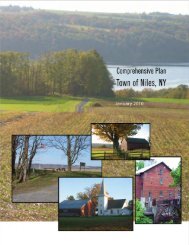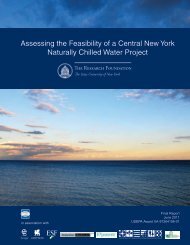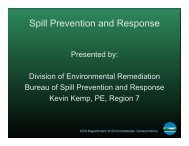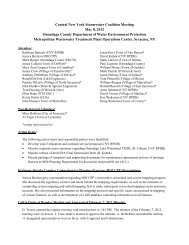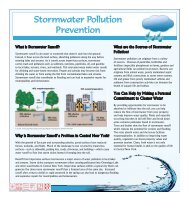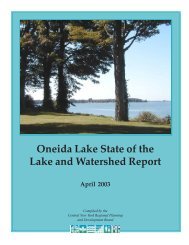A Management Strategy for Oneida Lake and its ... - CNY RPDB Home
A Management Strategy for Oneida Lake and its ... - CNY RPDB Home
A Management Strategy for Oneida Lake and its ... - CNY RPDB Home
Create successful ePaper yourself
Turn your PDF publications into a flip-book with our unique Google optimized e-Paper software.
flict-of-use issue between homeowners,<br />
boaters, <strong>and</strong> other user groups.<br />
Lack of Boating Courtesy: Boating<br />
courtesy issues can pose problems between<br />
fellow boaters <strong>and</strong> PWC users, motorized<br />
watercraft <strong>and</strong> non-motorized paddlers/<br />
sailboats, as well as between boaters <strong>and</strong> other<br />
user groups. Typical examples of a lack of<br />
courtesy between lake users include watercraft<br />
speeding past other boats that are at anchor,<br />
adrift, or moored. (Because New York State<br />
lim<strong>its</strong> vessel speed to 5 mph when within 100<br />
feet of the shore, a dock, pier, raft, float, or<br />
anchored boat, it is also against regulation).<br />
This kind of behavior can disturb fishing<br />
activities, <strong>and</strong> also creates strong wakes that<br />
may overpower smaller watercrafts. Courtesy<br />
<strong>for</strong> other boaters <strong>and</strong> lake users is an important<br />
component in a multiple-use recreation<br />
situation <strong>and</strong> the disrespect of others in regard<br />
to speed, noise, right-of-way rules, <strong>and</strong><br />
launching can result in tension <strong>and</strong> aggravation<br />
that takes away from lake enjoyment.<br />
Fishing Derby on <strong>Oneida</strong> <strong>Lake</strong> (Photo: Saltman)<br />
Navigation Issues: <strong>Oneida</strong> <strong>Lake</strong> boaters<br />
face a number of navigation issues that can<br />
cause problems or inconvenience. Misplaced<br />
buoys can misin<strong>for</strong>m users about necessary<br />
speeds, directions, or danger. Seasonal water<br />
levels are an issue of concern <strong>for</strong> many boat<br />
users <strong>and</strong> are also associated with lake bottom<br />
damage <strong>and</strong> shoreline erosion. Navigation<br />
issues also arise when storms cause downed<br />
trees, logs or debris limit or block routes <strong>and</strong><br />
access ramps. The cutting of submerged<br />
aquatic vegetation by watercraft propellers can<br />
result in dense mats of weeds washing into<br />
bays or along shorelines. Thick vegetative<br />
mats can also impede watercraft mobility <strong>and</strong><br />
clog propellers.<br />
Water Quality Impacts: The water<br />
quality of the lake can be negatively impacted<br />
by boat activity. Fuel loss <strong>and</strong> small spills<br />
from boats create only minor problems since<br />
slicks quickly volatize into the air. While fuel<br />
spills may not significantly degrade water<br />
quality, they can however, decrease people’s<br />
enjoyment of the lake <strong>and</strong> impair the swimming<br />
value of affected areas. Similarly, litter<br />
<strong>and</strong> trash in the water <strong>and</strong> along the shores<br />
decreases the aesthetic value of the lake <strong>and</strong><br />
can change the type of recreational experiences<br />
people have. Discharge of boat wastewater<br />
<strong>and</strong> sewage is not permitted <strong>and</strong> can<br />
contribute to lake pollution. Bank erosion is a<br />
source of sediment pollution that increases the<br />
turbidity of lake water <strong>and</strong> can be amplified<br />
by the wave action caused by boat wake.<br />
High speeds too close to shore can result in<br />
waves that damage shorelines, sea walls <strong>and</strong><br />
lead to long-term property loss. Personal<br />
watercraft also allow traffic in shallow areas<br />
of water that were previously unutilized.<br />
The National Marine Manufacturers Association<br />
has documented increasing trends in both<br />
the number of recreational boats owned, <strong>and</strong><br />
also in the average watercraft horsepower.<br />
Water turbidity can be exaggerated with speed<br />
as bottom sediments are stirred up <strong>and</strong> resuspended<br />
by the scouring action of propellers.<br />
The average recreational watercraft has a<br />
minimal influence on the lakebed in depths<br />
greater than 6-8 feet. PWC have the least<br />
impacts in waters greater than 3 feet deep.<br />
The greatest turbulence associated with boat<br />
wake was recorded at the ‘near plane’ operating<br />
speeds. There<strong>for</strong>e, the greatest damage by<br />
Chapter 3: Priority Areas page 75



